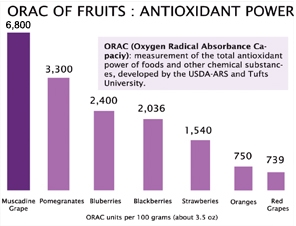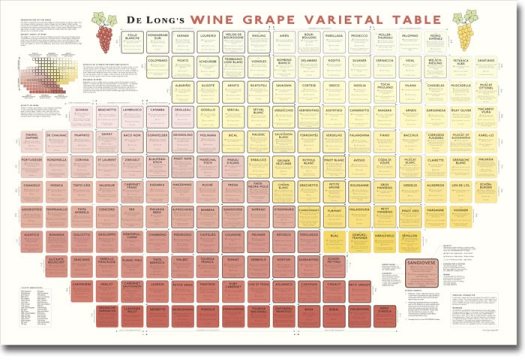What is the nutrient value of grapes? With all the talk about the health benefits of resveratrol and red wine, grapes should surely be healthy. What nutrients are in grapes?
According to Mississippi State nutritionist, Betty Ecktor*, on the North Carolina Department of Commerce Website, the nutrient value of grapes (100 grams of dark skinned grapes) have the following attributes:
| Protein 5 g Fat 0 g Carbohydrate 14 g Calories 76 g Sodium 7 mg Calcium 24 mg |
Potassium 167 mg Magnesium 7 mg Vitamin C 6 mg Dietary Fiber 3 g Resveratrol 1170 ug OPC’s** 2120 ug |
 |
See how the nutrient value of grapes compares to the Chemical Composition of Wine.
The Healthiest Grapes
In a study of hundreds of wines from around the globe, Cornell researcher Leroy Creasy found the highest resveratrol levels in pinot noir grapes. The pinot noir grapes he found the highest levels of resveratrol in were from cool, rainy places where the grapes had to fight off fungus and bacteria often. The hard to grow, pinot noir grape, is susceptible to rot which may be the reason it produces more resveratrol than other grapes (see How Much Resveratrol is in Grapes).
However, in a book titled “The Red Wine Diet”, Roger Corder of the William Harvey Research Institute, came to the conclusion that OPC’s, not resveratrol, was the reason behind the “French Paradox”. He points to the citizens of Gers, France who live longer than all other provinces in France. Corder attributes this to the local Madiran wines, made with Tannat grapes and notes – Tannat grapes have the highest concentration of OPC’s and are the healthiest grape – thus the longevity factor.
Nonetheless, these are the two that seem to be battling the most for the healthiest grape title. You can’t go wrong with one of those three. Here are some other notably healthy grapes varietals:
- The Cannonau Grapes from The Nuoro Province in Sardinia
- Nebbiolo Grapes from the Lombardy region of Italy
- Sagratino Grapes from Tuscany, Italy
- Cabarnet Sauvignon Grapes from the Chile or Argentina
- The Muscadine Grape from the North Carolina region of the U.S.
The Process of Becoming a Grape
The process of becoming a grape isn’t fast, and the nutrient value of grapes doesn’t actually occur until the final stages. In the beginning, the grape berries are green, bitter, hard to the touch and quite acidic.
Once they hit the stage called, veraison, the berry begins to ripen. At this point, which is 6 to 7 weeks after you’ve first noticed the hard berries, the nutrient value takes place. This is when the antioxidants rush into the grape thereby giving it its color.
This color changing is due to the chlorophyll in the grape skin being replaced by the resveratrol (natures antibiotic), the anthocyanins (OPC’s) and the carotenoids.
While the initial fruit development stage takes 6 weeks, the veraison stage takes 4 to 5 days; the growth of which is dramatic. In a process known as engustment, the berries begin to grow dramatically as they accumulate glucose and fructose and acids begin to fall.
The ORAC Value of Grapes

The ORAC is a measurement created by scientists at Tufts University in conjunction with the USDA. It’s goal is to measure the antioxidant capacity of samples of fruits and vegetables. The greatest benefit that is derived from ORAC testing is the ability to test different kinds of fruits and vegetables and have a common measurement.
There is a drawback, however. ORAC is normally used commercially as a comparison tool to show you that the antioxidant they’re selling have a higher ORAC value than other antioxidants. But 95% of the time it is used incorrectly. What you need to be careful looking at is what is being measured. Take for instance grapes and raisins. They have exactly the same ORAC value, but if the measurement is by weight raisins would be much higher because much of a grape’s weight is water.
Therefore, when looking at ORAC comparison charts, make sure they note how the fruits were measured. The above table shows fruits measured per serving, as whole fruits.
DeLong’s Wine Grape Varietal Table
Ever see a Wine Grape Varietal Table before? De Long’s Wine Grape Varietal Table is a wine reference guide disguised as wall art.

See all the grapes in terms of their sweetness or dryness, whether they’re red or white, heavy or light and all the details about the nutrient value of grapes.
From Nutrient Value of Grapes to Resveratrol Supplements
*Betty Ector’s References
Ector, B.J., A.S. Welch, E. Harkness and C.P. Hegwood. 1993a. Nutritional components of bronze muscadines: Levels of protein, carbohydrate, fat, dietary fiber, pectin and selected minerals and vitamins. Miss. Acad. Sci. 57th An. Meet., Abstr. 38:23.
Ector, B.J., A.S. Welch, E. Harkness and C.P. Hegwood. 1993b. Nutritional components of red muscadine grapes: Levels of protein, carbohydrate, fat, dietary fiber, pectin and selected minerals and vitamins. Southern Assoc. Agric. Scientists, Food Sci. Human Nutr. Sec., Abstr. 30:32.
Ector, B.J., J.B. Magee, C.P. Hegwood, and M.J. Coign. 1996a. Resveratrol concentration in muscadine berries, juice, pomace, purees, seeds, and wines. Am. J. Enol. Vitic. 47(1):57-62.
**OPC information from http://www.mycellessentials.com/opc
All citations refer to the “nutrient value of grapes” page on this website.